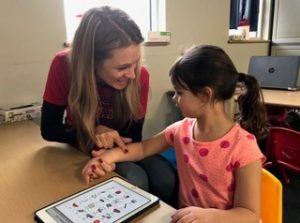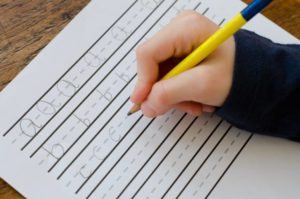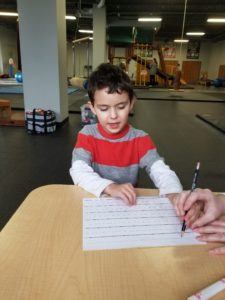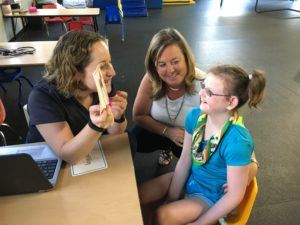Month: March 2018
Answering and asking questions is an important part of learning. We ask questions in order to learn more information about something, and we answer questions to provide more information. Asking and answering questions is not only a part of how we learn, but it is also a part of our social skills; we ask and answer questions to be polite and build and maintain relationships. Types of questions we ask and answer include “who”, “what”, “where”, “when”, and “why”.
Answering questions involves having a child hear the question, think about the meaning of the question, understand the meaning of the question, form an answer, and speak the answer that they formed. Asking questions involves thinking about what you want ask, forming the question in your mind, and then producing the question that you want to ask. For children with speech and language delays, asking and answering questions can be a challenge. This challenge in asking and answering questions may affect their ability to learn and their ability to develop and build relationships.
Believe it or not some questions are easier to ask/answer than others. “What” questions are the easiest to learn, followed by “Who”, then “Where”, followed by “When”, and finally “Why”; “Why” questions being the most difficult for children to learn and master.
The following is a basic guideline on the types of questions a child may ask/answer according to their age. More information can be found at: https://parentresourcesblog.files.wordpress.com/2013/05/questions-development.pdf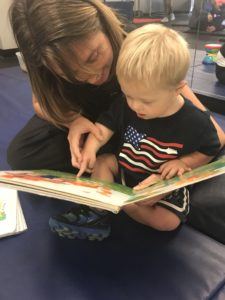
· Between 12-24 months, a child should be able to answer basic “What’s this?” questions about familiar objects, answer basic “where” questions by pointing, answer basic yes/no question by shaking their head or nodding, and use a rising pitch in their voice to indicate that they are asking a question (e.g., Daddy? to ask “Where is daddy?”)
· Between 24-36 months, a child should point to objects being described (e.g., “Where do you wear a hat” and the child points to their head), answer longer “Where”, “What…doing”, and “Who is” questions, understand “Can you” questions, ask questions to get their basic wants/needs met (e.g., “where cup?”), and ask one-word “why?” questions
· Between 36-48 months, a child should answer more complex questions, answer questions about object functions (e.g., what do you do with a spoon), and answer “if…what” questions (e.g., if you get sick, what would you do?)
If you find that your child is having difficulty asking/answering questions determine the type of question(s) that is the most problematic. Once you have figured out the type of question that is challenging for your child, talk about what it means to ask/answer that type of question. For example,
· “what” means we are talking about a thing, such as the dog, the house, a cracker, etc.
· “who” means we are talking about a person, like mommy and daddy, grandma/grandpa, etc.
· “where” means we are talking about a place or location, such as the park, our house, or in the kitchen.
· “when” means a time, such as daytime/nighttime, breakfast, summer, yesterday, or even a month like December
· “why” means a reason, such as I fell down because I tripped on a rock.
Once you have talked about the type of question that is troublesome, use games and activities involving questions to teach your child about asking/answering questions while having fun at the same time. Games and activities could include, but are not limited to: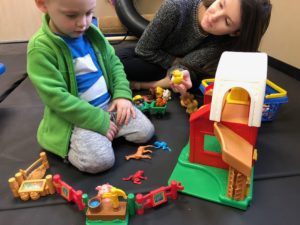
· “Wh” Bingo
· I Spy
· Asking questions while reading a book
· Asking questions while playing with toys (e.g., Where is the cow? What animal is this?)
· Headbanz Game
If your child is still struggling to ask/answer questions or other speech and language skills, it is recommended to seek out a Speech and Language evaluation from your local Speech Therapist to determine if your child would qualify from services to improve these skills. For more information visit https://www.abcpediatrictherapy.com
Read MoreAfter reading Prewriting Tips to Grow On and working on these skills with your child, you should be on the right track to begin handwriting letters and numbers with your child.
1. By 5, your child should begin writing numbers 1-5 and capital letters of his/her first name.
At first, give your child opportunities to trace the capital letters of his/her first name. Once they have mastered this and stay on the lines, they are able to begin writing the letters with a visual model. Focus on learning the appropriate formation of each letter, beginning all letters at the top rather than the bottom. Learning how to form letters correctly from the beginning helps them succeed later. Once your child’s formation of letters is appropriate, work on writing letters independently, without a visual model. When your child learns to write his/her name, s/he is ready to learn the rest of the alphabet.
2. By 5.5, your child should be able to write numbers 1-10 and all capital letters.
Start with capital letters A-M. Begin tracing, then writing with a visual model, and move onto writing independently. Then focus on N-Z following the same sequence. Lastly, put it all together, writing letters A-Z independently.
3. By around 6.5, your child should be able to write all lower case letters.
Follow the same sequence with lower case letters as you did with upper case letters. Lower case letters can also be divided into 3 different categories (tall, diver, and other letters) to teach.
Tall letters: b, d, f, h, k, l, t
Diver letters: g, j, p, q, y
If your child is having difficulty with letter formation, try making starting dots so your child knows where to begin each letter. Also writing in different mediums such as finger paint, sand, shaving cream, playdoh, chalk, and dry erase markers can help children learn how to form letters. Writing in different tactile mediums has been proven to help children learn to write.
After your child has mastered forming capital and lower case letters, it is now time to work on line alignment and sizing. Using horizontal three lined paper (ADD picture) with bold/colored top and bottom lines can assist with line alignment and sizing. Additionally, highlighting these boarders can help. Highlighting the space below the dotted line can help with alignment of lower case letters.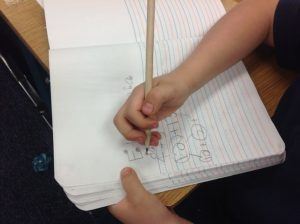
It is now time to move onto writing words and sentences. Make sure letters stay formed and aligned correctly when completing these tasks; sometimes when children begin to write words their formation and alignment decrease. You will now also have to focus on spacing letters within words and spacing between words. The best way to space between words is to use your child’s finger as a space marker.
Again, if you are having concerns or if you child is not progressing like you think s/he should, please do not hesitate to contact ABC Pediatric Therapy and specifically ask for an occupational therapist for more ideas geared towards your specific needs and if you have any additional questions or would like a free screening. Visit our website at www.abcpediatrictherapy.com to find the location nearest you.
Read More1. By a young age, encourage your child to color and explore using paper and crayons as this is an integral part of your child’s prewriting and fine motor development. Continue working on purposeful scribbling, coloring in large/small shapes, drawing (specifically people), and using your child’s creativity throughout his/her childhood.
2. By 2 years old, your child should begin grasping writing utensils in palm and imitating vertical lines.
3. By 2.5 years old, your child should be able to grasp a pencil with thumb and fingers instead of a fist and begin drawing horizontal lines.
4. By 3 years old, your child should begin drawing circles stopping within ½” of the endpoint and making crosses (+).
5. By 3.5 years old, your child should begin drawing X’s.
6. By 4 years of age, your child should begin having a static tripod grasp (grasp using 3 fingers but limited movement within fingers/wrist).
7. By 4.5 years of age, your child should begin to draw squares.
8. By 5, your child should begin drawing triangles and writing numbers 1-5 and capital letters of his/her first name.
9. By 5.5, your child should be able to write numbers 1-10 and all capital letters.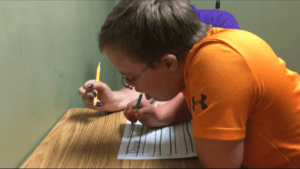
10. By around 6.5, your child should be able to write all lower case letters and have developed a dynamic tripod functional grasp.
If by 4, your child is demonstrating difficulty with holding a writing utensil (pencil, crayons, markers) with 3 fingers and maintaining a functional grasp, it is beneficial to use broken crayon pieces or color/write on a vertical surface as these two activities encourage use of a functional grasp.
Additionally, if your child is still demonstrating difficulty, there are hand strengthening activities you can complete to work on strengthening the specific muscles needed to hold/maintain a functional grasp:
1. Use tweezers to pick up small objects
2. Play with playdoh
3. Use thera-putty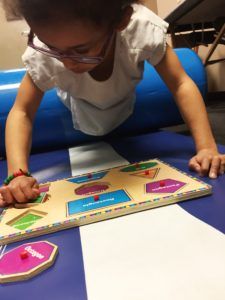
4. Engage with interlocking construction toys such as tinker toys or bristle blocks
5. Encourage water play with spray bottles, water guns, squirt toys, sponges, etc.
6. Clothes pin games
7. Hole punch activities
8. Squeeze toys and activities such as using glue
9. Weight bearing activities such as completing activities in prone (on stomach), wheelbarrow walking, animal walks, etc.
**Pencil grips should be used a last resort when teaching a child to hold a writing utensil as this hinders the development of functional grasp.
If you are having concerns or if you child is not progressing like you think s/he should, please do not hesitate to contact ABC Pediatric Therapy and specifically ask for an occupational therapist for more ideas geared towards your specific needs and if you have any additional questions or would like a free screening. Visit our website at www.abcpediatrictherapy.com to find the location nearest you.
Read MoreFrustration. We all experience moments of frustration, but the way in which we each handle our frustrations is very different and also very important. When children experience moments of frustrations it may include behaviors such as yelling, screaming, crying, hitting, etc. 
Does this sound familiar? Parents oftentimes feel overwhelmed and frustrated when their child is unable to communicate what is wrong or frustrating them and doing these undesirable behaviors. These frustrations and behaviors may actually be happening because your child is unable to effectively communicate to you what is wrong or what they want.
Let’s say you wake up in the middle of the night to your child crying and screaming. You are able to calm your child down, but they are still not able to tell you what is wrong with them. You know that something is wrong with your child, but you do not know the reason because your child cannot tell you; did they hit their head, have a bad dream, or are they sick? Only your child knows what is going on, but why won’t they tell you?
This type of situation can be both scary and frustrating for parents, but what can you do to help your child? Firstly, realize that children who have a difficult time communicating their wants/needs/ideas are more likely to become frustrated because their needs are not being met or they are not being understood. It is not necessarily that the child is trying to be bad, but that the child is so frustrated at not being able to communicate effectively that they communicate in the way that works for them which is the unwanted behavior. This decrease in communication and increase in frustration go hand-in-hand with children “acting out” or doing an unwanted behavior. When a child can effectively communicate their wants/needs/ideas, frustration and unwanted behaviors are more likely to decrease if the problem was an inability to communicate.
Secondly, make sure your child is on the right track developmentally with their speech and language.
Here are a few things to be on the lookout for:
· By 12 months of age, a child should begin making single words such as Mama, Dada, Doggie, Ball, Bye-bye, Hi, etc.
· By 24 months of age, a child should be using 2-word phrases frequently such as “bye-bye daddy”, “my ball”, “go potty” etc. and be able to identify basic body parts
· By 24 months of age, you should be able to understand approximately 50-75% of what a child is saying; you should be able to understand about half of what a child says.
· By 36 months of age, a child should be able to answer basic “wh” questions (e.g., “what’s your name”, “where does it hurt”, etc.) and be approximately 75% or more intelligible.
For more information on typical speech and language development in children up to six years of age, try our Interactive Screening Tool at checklist.abcpediatrictherapy.com.
If you notice that your child having a difficult time communicating, here are a few tips to try at home first:
· Use pictures or symbols that your child is familiar with. Have your child point to the picture or hand you the picture of what they are trying to communicate. Tell your child what you think their intention is and complete the task. For example, if your child points to the picture of the potty, say “Oh, you need to go potty. Let’s got to the potty” and take your child to the bathroom.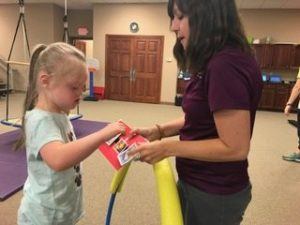
· Use basic hand signs and gestures with your child to help meet their basic wants/needs. Beginning signs to use with your child may include “more” and “all done.”
· Label items and objects with your child and talk about them.
· Incorporate music and play into your child’s daily activities.
· Talk and play with your child often. Children learn best through play and with other people face to face.
If your child’s communication skills do not begin to show improvement within a few weeks, it would be recommended to schedule a speech and language evaluation with your local Speech Therapist. For more information on speech and language development and speech therapy services, visit https://www.abcpediatrictherapy.com
Read More1. Understand the time your child should be able to attend to a seated task.
1 year: 1 minute
2 years: 2-4 minutes
3 years: 8 minutes
4 years: 10 minutes
5 years and up: 15 minutes
2. Give your child plenty of sensory/movement breaks throughout the day.
In today’s world, children are not given the breaks they need to function to their fullest potential. Allowing children to move around throughout the day will give them opportunities to let their energy out and ideally focus better when they are sitting. Running, climbing, jumping, and participating at recess is one of the best sensory motor activities a child can do at school. However, if the child needs more breaks or more structured activities during the day provide the following:
3. Provide proprioceptive input/heavy work through the school day.
Proprioceptive input activities involve heavy resistance and input to the muscles and joints. Engaging in these activities may help regulate a child’s arousal level, concentration, and ability to sit still/attend to a task.
· Wall/chair push ups
· Animal walks like crab walks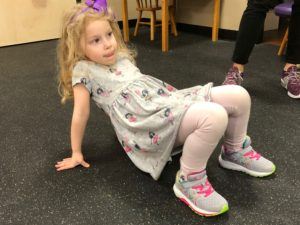
· Jumping up and down
· Sit ups
· Push ups
· Jumping jacks
· Wheelbarrow walks
· Arm Squeezes/self-hugs
· Complete activities in prone/on belly
· Chew on tougher consistencies, chew tubes, or hard candy
· Drink water through a straw
· Play oral motor games with straws during breaks
· Eat crunchy foods at meal times
· Apply a weighted blanket 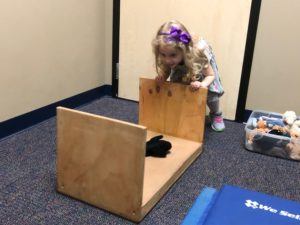
· Wear tighter clothing
· Pushing/pulling heavy objects
· Give the child more chores to complete around the classroom—wiping off dry erase/chalk board, putting up/pushing in chairs, washing tables, rearranging book shelves, sharpening pencils, carrying heavy boxes, cutting thick paper, etc.
4. Do these activities at home to continue regulating your child’s body. This can even help with homework time if your child is having a hard time concentrating at home.
5. Make breaks cards so your child is not abusing getting out of work both at work and at school.
Make a card for teacher’s choice, child’s choice, and proprioceptive input/heavy work. Have at least 2 of each type of card.
6. Talk to the teacher to determine if there are environmental changes that can be made.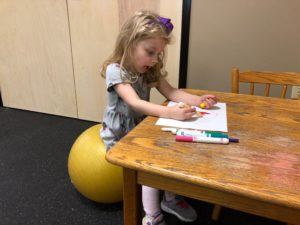
Could your child benefit from fidgets, wiggle seats, or TheraBand applied to their desk? Does your child have to sit on the floor during circle time? See if your teacher could use a designated carpet square to make a specific area for your child to sit.
7. Reflex Integration Testing
It may be beneficial to contact ABC Pediatric Therapy to have your child’s reflexes tested. Some of your child’s reflexes may not have integrated correctly when s/he were a baby which could cause difficulty with attention/focus, sitting upright in a chair, and some other deficits that are inhibiting your child’s full potential to learn.
8. Contact ABC Pediatric Therapy specifically an occupational therapist for more ideas geared towards your specific needs and if you have any additional questions. Visit our website at www.abcpediatrictherapy.com to find the location nearest you.
Read More Skip to content
Skip to content
